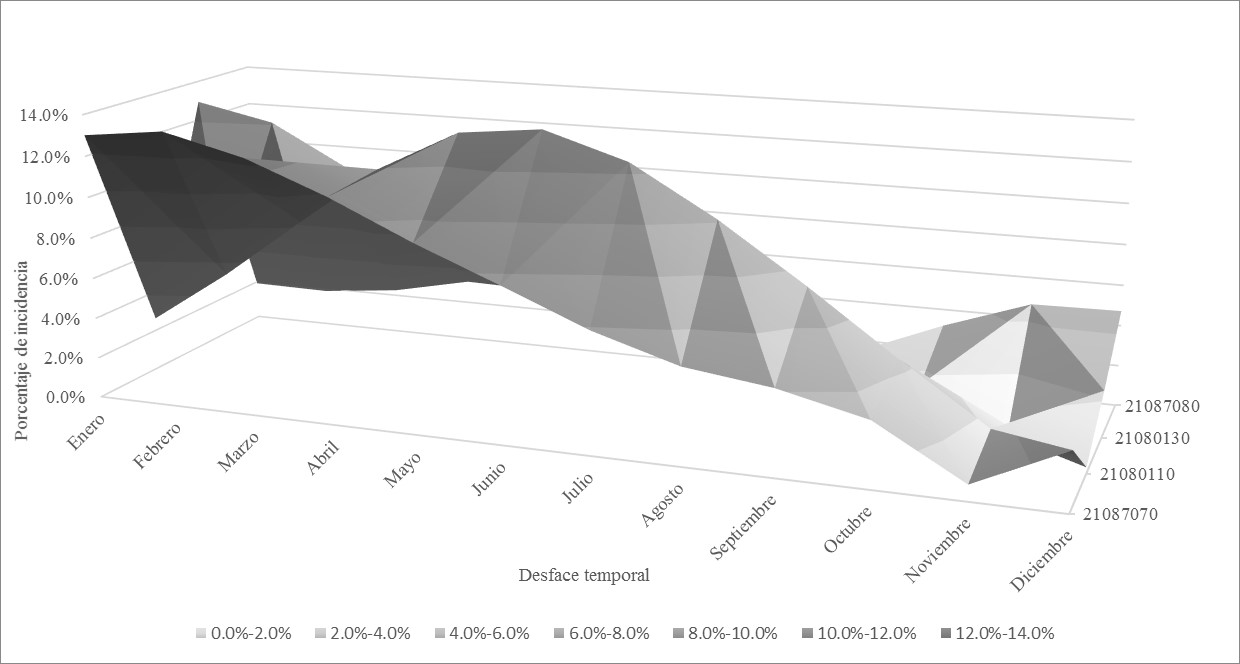Effect of Quasi-Biennal Oscillation phenomenom to the tributaries of Betania’s reservoir
Efecto del fenómeno de la Oscilación Cuasi-Bienal en los afluentes del embalse de Betania


This work is licensed under a Creative Commons Attribution-NonCommercial-NoDerivatives 4.0 International License.
Copyright statement
The authors exclusively assign to the Universidad EIA, with the power to assign to third parties, all the exploitation rights that derive from the works that are accepted for publication in the Revista EIA, as well as in any product derived from it and, in in particular, those of reproduction, distribution, public communication (including interactive making available) and transformation (including adaptation, modification and, where appropriate, translation), for all types of exploitation (by way of example and not limitation : in paper, electronic, online, computer or audiovisual format, as well as in any other format, even for promotional or advertising purposes and / or for the production of derivative products), for a worldwide territorial scope and for the entire duration of the rights provided for in the current published text of the Intellectual Property Law. This assignment will be made by the authors without the right to any type of remuneration or compensation.
Consequently, the author may not publish or disseminate the works that are selected for publication in the Revista EIA, neither totally nor partially, nor authorize their publication to third parties, without the prior express authorization, requested and granted in writing, from the Univeridad EIA.
Show authors biography
Colombia is one of the countries characterized for a high spatial-temporal variability of hydroclimatological variables defined by a wide range of macro climatic phenomena. One of this is the Quasi-Biennal oscillation phenomenom, which hasn’t been too much studied in the national context. In the survey was evaluated the phenomenom’s incidence over the water regime of the tributaires of Betania’s reservoir, who is important from the point of view of hydropower production and agricultural activity. It was encountered that the macro climatic event could show itself in a term from 4 to 7 months and its contribution to the year-on-year variability of flows is even of the 13.7%. taking into account that the anthropic interventions in the area affect the levels of the flows where the results are reflected when obtaining the correlations.
Article visits 647 | PDF visits 347
Downloads
- Bernard, Y. (24 de octubre de 2014). Obtenido de Test sobre muestras gaussianas: http://ljk.imag.fr/membres/Bernard.Ycart/emel/cours/ts/node14.html
- Carmona, A., & Poveda, G. (2012). Application of hilberthuang transform to detect hydroclimatic variability modes in Colombia. DYNA, 72-80.
- Edsand, H. (2017). Identifying barriers to wind energy diffusion in Colombia: A function analysis of the technological innovation system and the wider context. Technology in Society, 49, 1-15.
- EMGESA. (08 de Marzo de 2016). Niveles de embalse de Betania con tendencia a la baja . Comunicado de prensa EMGESA.
- EMGESA. (14 de Mayo de 2017). Emgesa abre compuertas del embalse de Betania con el fin de amortiguar crecientes del río Paez y Yaguará. Comunicados de prensa EMGESA.
- Enciso, A., Carbajal, Y., & Sandoval, M. (2016). Hydrological analysis of historical floods in the upper valley of Cauca river.
- Ingeniería y Competitividad, 18, 46-57.
- Fonseca, E. (2014). INFLUENCIA DE LOS FENÓMENOS DE VARIABILIDAD CLIMÁTICA INTRAESTACIONAL E INTERANUAL SOBRE EL COMPORTAMIENTO DE LA PRECIPITACIÓN Y LA TEMPORADA EN LA CIUDAD DE BOGOTÁ D.C. Bogotá: Universidad Central.
- Franquet, J. (2003). Cinco Temas de Hidrología e Hidráulica (1 Ed ed., Vol. 1). Tarragona, España: Tortosa (Tarragona) Bibliográfica Internacional. Recuperado el 25 de 10 de 2017, de https://books.google.com.co/books?id=C8y8-iPf1oYC&pg=PA360&lpg=PA360&dq=medias+moviles+en+hidrologia&source=bl&ots=2Qj7eDAoQR&sig=mufpbjQFniEN6I969LUNPlW_P4g&hl=es&sa=X&ved=0ahUKEwj5w4npzozXAhUJRCYKHQbsAOAQ6AEIJDAA#v=onepage&q=medias%20moviles%20en%20hidr
- Gabis, I. (2014). Quasi-biennial oscillation (QBO) of tropical total ozone under alternative QBO scenarios of equatorial stratospheric wind. Advances in Space 54, 2499-2510.
- Manuel David Zuluaga Arias, J. E. (s.f.). RELACION ENTRE LAS FASES DE LA OSCILACION CUASIBIENAL (QBO), LA PRECIPITACION MENSUAL Y LA RADIACION DE ONDA LARGA EMERGENTE EN COLOMBIA. Bogotá: Universidad Nacional.
- Montealegre, J. (2009). ESTUDIO DE LA VARIABILIDAD CLIMÁTICA DE LA PRECIPITACIÓN EN COLOMBIA ASOCIADA A PROCESOS OCEANICOS Y ATMOSFÉRICOS DE MESO Y GRAN ESCALA. Bogotá: INSTITUTO DE HIDROLOGIA, METEOROLOGIA Y ESTUDIOS AMBIENTALES, IDEAM.
- Palacio, A. (2013). INVENTARIO DOCUMENTADO DE REPRESAS EN COLOMBIA. Bogotá: UNIVERSIDAD MILITAR NUEVA GRANADA.
- Peña, C. (2006). Variabilidad climática estratosférica asociada a la QBO. Universidad Complutense de Madrid. Madrid, España:
- Universidad Complutense de Madrid.
- Poveda, G. (2004). LA HIDROCLIMATOLOGÍA DE COLOMBIA: UNA SÍNTESIS DESDE LA ESCALA INTER-DECADAL HASTA LA ESTALA DIURNA. Revista Academica Colombiana Ciencia, 2001-222.
- Poveda, G., Álvarez, D., & Rueda, O. (2011). Hydro-climatic variability over the Andes of Colombia associated with ENSO: a review of climatic processes and their impact on one of the Eath's most important biodiversity hotpots. Clim Dyn, 2233-2249.




